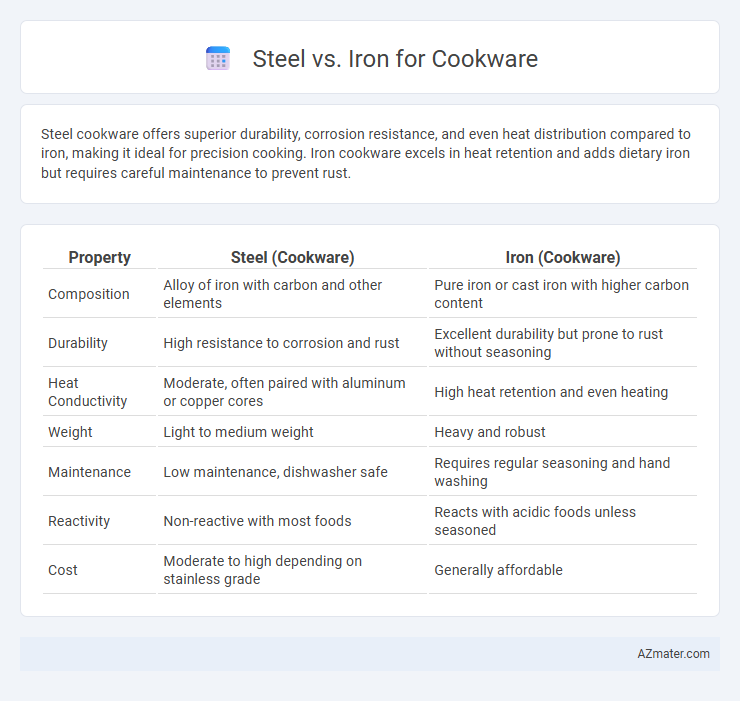Steel cookware offers superior durability, corrosion resistance, and even heat distribution compared to iron, making it ideal for precision cooking. Iron cookware excels in heat retention and adds dietary iron but requires careful maintenance to prevent rust.
Table of Comparison
| Property | Steel (Cookware) | Iron (Cookware) |
|---|---|---|
| Composition | Alloy of iron with carbon and other elements | Pure iron or cast iron with higher carbon content |
| Durability | High resistance to corrosion and rust | Excellent durability but prone to rust without seasoning |
| Heat Conductivity | Moderate, often paired with aluminum or copper cores | High heat retention and even heating |
| Weight | Light to medium weight | Heavy and robust |
| Maintenance | Low maintenance, dishwasher safe | Requires regular seasoning and hand washing |
| Reactivity | Non-reactive with most foods | Reacts with acidic foods unless seasoned |
| Cost | Moderate to high depending on stainless grade | Generally affordable |
Introduction to Steel and Iron Cookware
Steel cookware, especially stainless steel, offers exceptional durability, corrosion resistance, and non-reactive cooking surfaces, making it ideal for a variety of culinary tasks. Iron cookware, primarily cast iron, provides superior heat retention and even heat distribution, favored for searing and slow cooking but requires seasoning to maintain its non-stick properties and prevent rust. Both materials serve distinct purposes in the kitchen, with steel emphasizing low maintenance and iron excelling in heat performance.
Key Differences Between Steel and Iron
Steel cookware offers superior resistance to rust and corrosion due to its alloyed composition, making it more durable and easier to maintain than traditional iron cookware. Iron, especially cast iron, excels in heat retention and even distribution, which is ideal for slow cooking and searing, but requires regular seasoning to prevent rusting. The primary difference lies in steel's versatility and low maintenance compared to iron's superior heat performance and natural non-stick properties when properly seasoned.
Heat Conductivity and Retention
Steel cookware, particularly stainless steel, offers moderate heat conductivity and excellent heat retention, making it ideal for even cooking and maintaining temperature over time. Iron, especially cast iron, excels in heat retention due to its dense composition but has slower heat conductivity, resulting in longer preheating times and consistent heat distribution. For precise temperature control and durability, steel is preferable, while iron is favored for its superior heat retention and ability to withstand high cooking temperatures.
Durability and Longevity
Steel cookware, especially stainless steel, offers superior durability due to its resistance to rust, corrosion, and warping compared to traditional iron cookware. Cast iron, while heavier and prone to rust without proper seasoning, is highly valued for its exceptional heat retention and can last multiple generations with proper care. Steel's non-reactive surface requires less maintenance, making it a long-lasting choice for everyday cooking, whereas iron demands regular upkeep to maintain its longevity.
Maintenance and Care Requirements
Steel cookware, especially stainless steel, offers superior resistance to rust and corrosion, requiring minimal maintenance compared to iron. Iron cookware, such as cast iron, demands regular seasoning to maintain its non-stick surface and prevent rusting, necessitating careful drying and oiling after each use. Proper maintenance extends the lifespan of both materials, but iron requires more consistent effort to preserve its cooking performance and durability.
Cooking Performance and Versatility
Stainless steel cookware offers excellent heat distribution and retention, making it ideal for precise cooking techniques like searing and sauteing, while cast iron excels at maintaining steady heat for slow cooking and frying. Stainless steel is non-reactive and suitable for acidic foods, whereas cast iron provides natural non-stick properties when properly seasoned. Both materials are versatile, but stainless steel's durability and ease of maintenance make it preferred for everyday use, while cast iron's superior heat retention benefits high-heat recipes and oven cooking.
Health and Safety Considerations
Steel cookware, particularly stainless steel, offers strong resistance to rust, corrosion, and leaching, making it a safe choice for health-conscious cooking. Iron cookware, especially cast iron, provides natural non-stick qualities and can increase dietary iron intake, but improper seasoning or rusting may pose safety concerns. Both materials require proper maintenance to avoid contamination and ensure long-term safe use in the kitchen.
Cost Comparison: Steel vs Iron
Steel cookware generally costs more upfront than iron due to its complex manufacturing processes and alloy composition, often ranging from $30 to $100 per piece. Iron cookware, particularly cast iron, offers a more budget-friendly option with prices starting as low as $15 but may require seasoning and maintenance to prevent rust. When considering long-term durability and performance, steel's corrosion resistance can justify its higher initial price, while iron's affordability and heat retention remain attractive for cost-conscious cooks.
Pros and Cons of Steel Cookware
Steel cookware offers excellent durability and resistance to rust and corrosion, making it ideal for long-term use in kitchens. It provides even heat distribution and is often non-reactive, ensuring flavors remain pure, but it can be heavier and may require seasoning to maintain a non-stick surface. However, steel can be prone to warping under high heat and typically lacks the natural non-stick properties of iron cookware.
Pros and Cons of Iron Cookware
Iron cookware offers excellent heat retention and even heating, making it ideal for searing and slow cooking. Its durability allows it to last for generations, but iron requires regular seasoning to maintain its non-stick surface and prevent rust. However, the cookware's heavy weight and potential for reactivity with acidic foods can be drawbacks for everyday use.

Infographic: Steel vs Iron for Cookware
 azmater.com
azmater.com